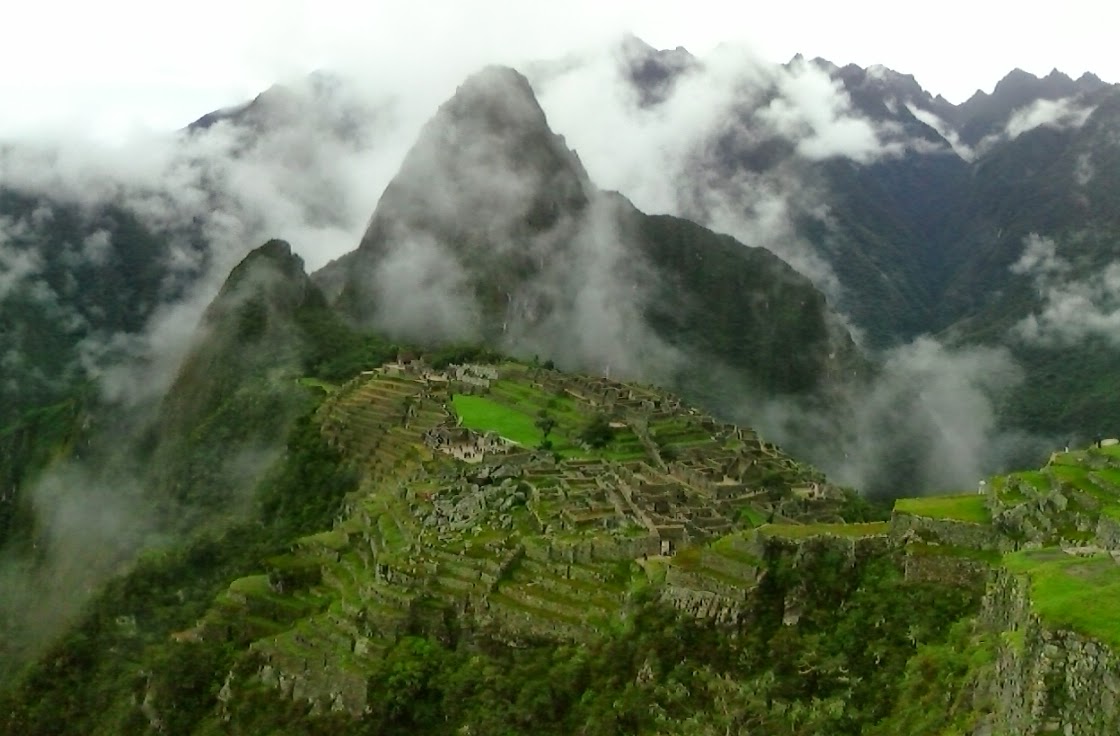 |
| The Door of Amaru - near Juli, Peru |
From Juli, Peru (near the border with Bolivia) to Cusco, Peru are a mix of ruins with accompanying lore, sacrificial rites, historic churches and beautiful scenery. I visited the church of in Juli, the Door of Amaru near Juli and Sillustani while still in Puno.
The Door of Amaru (pictured above)
I took a collectivo from Puno to the town of Juli close to the Bolivian Border for the purpose of visiting the Door of Amaru. While enroute, I saw some very interesting rock formations. It turned out this is where the door was. The area where the door is carved looks like bedrock that has been broken up and turned perpendicular. There are a number of legends surrounding the door. One legend says that it is the Gateway to the Gods; that heroes could pass through this door to live eternally with the gods. One story is of an Incan priest that passed through this door with a sacred golden disk to protect it from the Spaniards. Other legends include star gate for interstellar travel and devil's gate as a location where demons can enter the earth. I tried to open it, but could not.
 |
| Possibly it was a kind of natural amphitheater where the door was the stage |
 |
| Interesting rock formations near the door |
 |
| More interesting rock formations near the door |
Sillustani
Sillustani is an archeological area about 35km from Puno towards Cusco. It is a hill that at one time may have been an island as it has water bodies on each side. Essentially, Sillustani was a cemetery for important people. The tombs, called chullpas, were built above ground with stone in a circular fashion with a domed roof. Many of the tombs were in disrepair due to either lightening strikes, earthquakes or tomb raiders. In each tomb, the important person would be buried with their wife, family and servants many of which were sacrificed. It is obvious the different tombs were constructed at different periods as they used different methods and different quality of stones.
 |
| Sillustani with the sun beaming down |
 |
| A chullpa constructed more with mortar and stone (more mortar) |
 |
| One of the few chullpas in good condition |
 |
| This chullpa was in the process of being constructed. The ramp was used to raise the large stones |
 |
| This chullpa came down most likely due to earthquake or lightening strike |
 |
Notice the very fine cutting on these stones. These are very flat surfaces.
Much higher quality work than most of the other chullpas. |
 |
| Plateau island next to Sillustani |
Kalassaya Archeological Site and the Lítico Meseum in Pucara
 |
| Kalassaya |
Kalassaya is a pyramid like complex that has a number of interesting features. It has tunnels that have never been fully explored. One guy in our tour group crawled through one of the tunnels. Found on this site, was a monolith of a priest holding a head in one hand and a knife in the other. Additionally, on the archeological site is the incomplete foundation for a church and in that church were found human skulls with no bodies.
 |
| Monolith of priest with head and knife |
 |
| Abandoned church foundation |
 |
| This guy just crawled through about 20 meters of underground tunnel |
 |
| A sunken ceremonial site |
Racchi Arqueological Site
 |
| Racchi Main Temple building |
Racchi was an administrative point for the Incas. It is comprised of a main temple building (92 meters long and 20 meters in height), a number of residences for important inca leaders and a large number of storage vessels for storing taxed goods (primarily corn, potatoes, quinoa, and dried meats).
 |
| Residential |
 |
| Storage units (colcas) |
Iglesia de San Pedro de Andahuaylillas
Iglesia de San Pedro is known as being the 16th church in the Americas. It was probably constructed towards the end of the 16th century, while some of the interior paintings show dates of early 1600's.
 |
| The road to heaven and hell |
The following painting depicts the martyrdom of Saint Peter with the decapitation of his head. According to wikipedia, Saint Peter was cruicified upside down. My guess is that the decapitation is to help the indigenous people relate given that decapitation was practiced by their priests. This is Saint Paul and there is a painting of Saint Peter on the cross. I did not see this correctly
 |
The martyrdom of Saint PeterPaul |
Another thing I noticed is that saintly individuals had a halo that looked like sun rays. I believe this was also to help the indigenous relate to the church.
Pikillacta
Pikillacta was like a gate between two mountains. It most likely served as check point much like today's border control stations.
 |
| Pikillacta |
Nice Scenery on the Road
 |
| Llamas at El Paso La Raya |
 |
| At El Paso La Raya |































































